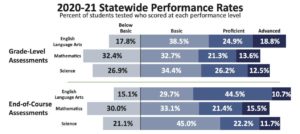(The Center Square) – Missouri Education Commissioner Margie Vandeven mentioned two metaphors for using 2021 student test scores – as a flashlight or hammer.
“They can shed light on circumstances and provide insight, or as a hammer as an accountability tool,” Vandeven said. “So this year, let’s focus on the flashlight.”
Light revealed Missouri’s youngest and most vulnerable students were hammered by pandemic school closings and remote learning as the state Department of Elementary and Secondary Education (DESE) released its 2021 Missouri Assessment Program results.
In language arts, 29% percent of third graders tested below basic levels. In math, 34% of third graders and 35% of fourth graders tested below basic levels. In all content areas and grades, 74% of students receiving free-and-reduced lunches and 87% of students with an individualized education plan (IEP) rated at the basic level or below.
Vandeven emphasized comparing the scores to previous years ignores the variables encountered during the pandemic. The state board of education voted in December 2020 to waive the test results for state and federal accountability. Testing was canceled after schools closed in March 2020 due to pandemic restrictions.
“The COVID-19 pandemic continued to present a number of unique challenges for students, families, schools and educators alike,” Vandeven said. “Teachers and students were absent for extended periods of time due to illness and quarantine. Teachers and students were experiencing unparalleled stress, fatigue and mental health issues. Students were often learning throughout the year with new and changing modes of instruction, be it in-person, hybrid, or fully remote. Sometimes technology and a less-than-reliable Internet connection played into that.”
Susan Pendergrass, director of research and education policy at the Show-Me Institute, expected troubling scores, but said the actual results of young students were alarming.
“We have about 30,000 testing below basic and 70,000 at the basic level, so that’s 100,000 kids and I was worried about them before the pandemic,” Pendergrass said. “If you’re not reading fluently by third or fourth grade, it’s going to impact the rest of your education. We lost ground and it’s very upsetting.”
DESE tested fewer students than in previous years. In addition to a 3% decline in enrollment, students learning virtually were required to take the test in a school building.
Data showed 51% of students were in school classrooms last school year and 31% were hybrid – onsite at least two days per week or receiving instruction in a combination of modes. The remaining 18% were virtual and distanced – offsite with online instruction.
Although DESE stated it doesn’t indicate a cause-and-effect relationship, 46% of virtual students and 56% of distanced students tested below basic in math.
“Virtual learning was a failure,” Pendergrass said. “Half the kids are below basic and DESE describes below basic as a student having only a minimal understanding of the material. The most disadvantaged students obviously suffered the most. And that’s not surprising to me.”
Because the test scores can’t be compared to previous years, DESE advised organizations to not use the test scores to make “high-stakes decisions.”
Millions in federal pandemic relief funds were distributed to school districts and to DESE to assist education. Vandeven said the test scores will help educators assess effectiveness of funding programs.
“One of the questions in completing any state or district [funding] plan has been, Which students were most significantly impacted?” Vandeven said. “We have to be able to answer that question and this will help inform that question. On the other side of that, 10 years from now when we’re looking back on where investments were made, it’s going to be really important to be able to have this data.”

 Missouri Department of Elementary and Secondary Education
Missouri Department of Elementary and Secondary Education